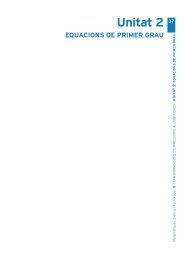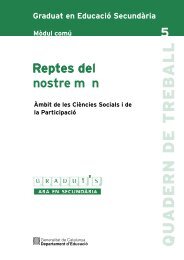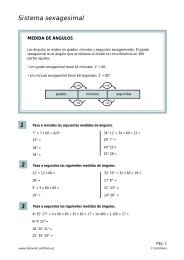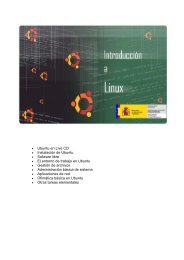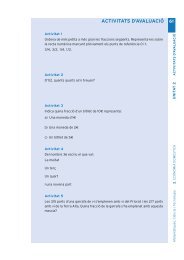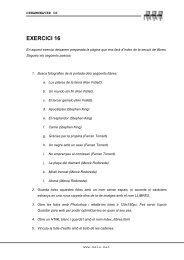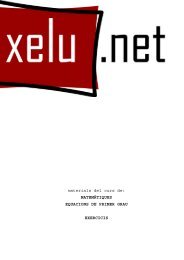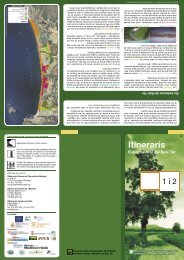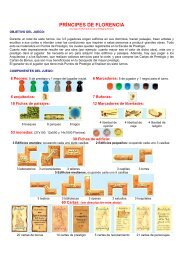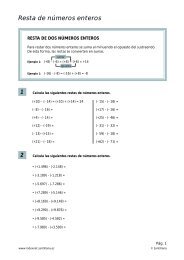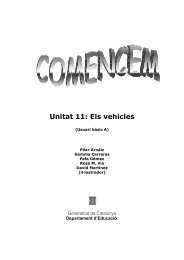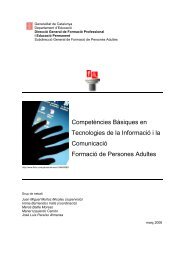COMPONENTS
COMPONENTS
COMPONENTS
Create successful ePaper yourself
Turn your PDF publications into a flip-book with our unique Google optimized e-Paper software.
<strong>COMPONENTS</strong><br />
A game of agriculture and development for 1-5 players by Uwe Rosenberg<br />
Playing time: Half an hour per player, shorter as a family game. Age: From 12 years.<br />
Central Europe, around 1670 AD. The Plague which has raged since 1348 has been overcome.<br />
The civilised world is revitalised. People are upgrading and renovating their huts. Fields must<br />
be ploughed, tilled and harvested. The famine of the previous years has encouraged people to<br />
eat more meat (a habit that we people of growing affluence have still not abandoned today).<br />
GAME BOARDS:<br />
• 5 farmyards for the players (with farmyard spaces as well as<br />
1 example on thereverse)<br />
• 3 game boards for the game actions (including one with an alternative<br />
reverse side for the family game, as well as two examples)<br />
• 1 board for Major Improvements (+ scoring summary on the reverse side)<br />
360 CARDS:<br />
• 166 yellow "Occupation" cards (66 cards for 1-5 players,<br />
40 cards for 3-5 players, 60 cards for 4-5 players)<br />
• 136 orange "Minor Improvement" cards (including<br />
7 upgrades from Major or Minor Improvements)<br />
• 10 red "Major Improvement" cards<br />
• 16 blue Round cards with possible actions for rounds 1 to 14<br />
(including 2 blank cards)<br />
• 16 green Action cards with possible actions<br />
that depend on the number of players<br />
• 8 grey begging cards<br />
• 6 summary cards<br />
• 2 deck cards (1 interactive deck, 1 complex deck)<br />
WOODEN PLAYING PIECES:<br />
• 5 Family member discs, 4 stables and 15 fences in each<br />
of the five player colours (blue, green, red, natural and purple)<br />
• 33 round, brown Wood counters<br />
• 27 round, red Clay counters<br />
• 15 round, white Reed counters<br />
• 18 round, grey Stone counters<br />
• 27 round, yellow Wheat counters<br />
• 18 round, orange Vegetable counters<br />
• 21 Sheep tokens (white cubes)<br />
• 18 Wild Boar tokens (black cubes)<br />
• 15 Cattle tokens (brown cubes)<br />
• 1 Starting player token<br />
AND ALSO:<br />
• 18 brown Field tiles<br />
• 24 Wood/Clay hut tiles (Hut tiles)<br />
• 15 Stone house tiles (House tiles)<br />
• 36 yellow Food markers (NW) labelled "1"<br />
• 9 Multiplication markers (can apply to animals, goods of Food)<br />
• 3 Claim markers with "Guest" (Gast) on the reverse<br />
• and 1 Scoring pad
OBJECT OF THE GAME<br />
A hut with two rooms, for the couple to live in – at the start of the game, this<br />
is all that the players have. The action spaces offer players abundant possibilities<br />
to improve their quality of life by building their home, improving their fields<br />
and breeding their animals. In each round, a new possible action is added – see<br />
Overview of game phases. In each of the 14 rounds, each member of a player’s<br />
family may take exactly one action. They can generate resources such as wood<br />
and clay, add more people to their family and ensure that they are fed. In each round,<br />
each action can only be taken by one person – players will miss out if another<br />
player chooses the action first. You must plan to grow your family at the right time<br />
– but not too soon, because even the next generation must be fed. Expanding your<br />
family is important, though, because it allows you to take more actions as more<br />
possibilities become available. At the end of the game, the winner is the player who<br />
has established the best farmyard- see Scoring overview. Victory points are awarded<br />
for the number of fields, pastures and fenced stables, as well as for wheat, vegetables<br />
sheep, wild boar and cattle. Each unused space loses the player1 point. Additional<br />
points are awarded for developing the player’s home,for family members<br />
and for played Occupation and Improvement cards.<br />
On the back of these rules and one of farmyard boards are examplesto<br />
assist in understanding these rules.<br />
Note: The terms "Person" and "Family<br />
Member" are used in the rules and<br />
on the game cards to mean the round<br />
Family Member discs (see illustration);<br />
"Player" means the humans who are<br />
taking part in a game of Agricola.<br />
The term "Other players" means<br />
all other players - so not the player<br />
taking the action.<br />
PREPARING TO PLAY<br />
Place the three game boards as shown in the illustration to the right.<br />
Each player chooses a colour and takes one farmyard, which is placed in front of the player<br />
(facing in whichever direction the player chooses). Oneach of the two building spaces on<br />
this farmyard, players place first awooden hut and then (in each of these rooms) one of<br />
their family members (see Illustration). The remaining playing pieces (additionalfamily<br />
members, fences and stables) remain in the bag for now. Sort theremaining house and hut<br />
tiles and the rest of the game components andplace them to one side of the playing area.<br />
CARDS<br />
Sort the cards according to the colour of the reverse side.<br />
Depending on the number of players, different blue Round cards (A) andgreen Action<br />
cards (B) are used (see Illustration). There are also yellow Occupation cards (C), orange<br />
“Minor Improvement” cards (D), red “MajorImprovement” cards (E), grey Begging<br />
cards (F) and Summary cards (G).<br />
Reverse sides:<br />
The first gameboard has adifferent<br />
reverseside which is usedfor the<br />
simplifiedfamily version.<br />
The other two gameboards should be<br />
face-downduring the rulesexplanation.<br />
Theyhave illustrativeexamples. The<br />
reverse sides ofthe farmyards can be<br />
used as supplyareas for game<br />
components, if thefarmyards are not in<br />
use in the game.<br />
A. Turn the blue Round cards face up and sort them according to the<br />
Stage of the game. Shuffle each small pile and place the piles on top<br />
of each other with the cards for Stage 6 at the bottom, Stage 5 on top<br />
of that, etc – with the four cards for Stage 1 on the top. The Round<br />
cards bring new possible actions into the game.<br />
(These arelisted on the game summary cards and in the Appendix,<br />
section2.2).<br />
B. Place the green Action cards that apply to the number of players<br />
face up on the spaces to the left of the first game board (see illustration).<br />
The order in which the cards are laid out is irrelevant. In a 3-player game,<br />
there are 4 cards, in a 4 and 5 player game there are 6 cards. (There is<br />
more information about these cards in the Appendix, section 2.3). In solo<br />
and 2-player games, no green action cards are required.<br />
C. To the left on the yellow Occupation cards is a purple symbol<br />
showing how many players the card is used for: [1+] means for 1-5<br />
players, [3+] for 3-5 players, [4+] for 4-5 players. Cards that are not in<br />
use are removed from the game. The full deck ofOccupation cards is<br />
only used in a 4- or 5-player game.Shuffle thecards. Each player takes<br />
7 Occupation cards into their hand andmay look through them. The<br />
remainingcards are removed from the game.<br />
The "Occupation" and "Minor<br />
Improvement" cards are divided into<br />
3 decks – an entry deck (E), an<br />
interactive deck (I) and a complex<br />
deck (K). Players can play with cards<br />
from only one deck, or<br />
can shuffle the decks<br />
together. The deck that a<br />
card belongs to is indicated<br />
by the symbol at the top<br />
right of the card.
D. Shuffle the orange Minor Improvement cards. Each player takes<br />
7 Minor Improvement cards into into their hand and may look through<br />
them. The remaining cards are removed from the game.<br />
E. Place the 10 red Major Improvement cards face up on the<br />
Major Improvements board. As soon as 9 Major Improvements<br />
have been bought, the board is turned over and the remaining Major<br />
Improvement is placed on the space on the reverse of the board.<br />
In the Family Game variant the<br />
yellow Occupation cards and the<br />
orange Minor Improvement cards are<br />
not used. Apart from that, all the rules<br />
of the full game apply. In addition,<br />
1 Food is placed on the "Start player<br />
and Storehouse" (Startspieler und<br />
Lagerhaus) action space at the start<br />
of each round (see reverse of the left<br />
game board and page 10).<br />
F. Place the grey Begging cards in a handy face-up pile to the side<br />
of the playing area.<br />
G. Each player takes a summary card and places it in their<br />
playing area: One side of the card gives an overview of the<br />
game phases, the other explains the scoring at the end of the<br />
game. No scoring is done during the game.<br />
STARTING PLAYER<br />
Players choose a starting player, who receives the starting player marker and 2 Food.<br />
The other players each receive 3 Food. The starting player marker is not automatically<br />
passed on to the next player at the end of a round: it passes to the player who chooses<br />
the “Starting player” (Startspieler) action (see illustration).<br />
( )<br />
PLAY OF THE GAME<br />
The game consists of 14 rounds.<br />
Each round follows the same pattern and consists of four phases, which are followed by<br />
a harvest after each of rounds 4, 7, 9, 11, 13 and 14.<br />
PHASE 1: START THE ROUND - DRAW A NEW ROUND CARD<br />
Turn over the top card of the pile of Round cards and place it on the<br />
appropriate space on the board. This new action is available to all players,<br />
and can be used not only in this round but in all following rounds. The text<br />
of some Occupation and Improvement cards instructs the players to place<br />
items on the Action card spaces (In the example, Ploughman (Pflüger)<br />
and Goose pond (Gänseteich)). If there are already tiles, Food markers<br />
and/or other playing pieces on the space (In the example, 1 field and 1<br />
Food marker), these go to the appropriate players (who earned them<br />
through an Occupation or Improvement). The functions of the cards are<br />
explained on page 9. All actions which occur at the beginning of a particular<br />
round or at the beginning of every round occur now.<br />
PhAsE 2: REPLENISHING - THERE ARE NEW MATERIALS AND ANIMALS<br />
In the Replenishing phase of each round, new playing pieces are placed on many action<br />
spaces on the board (the printed spaces as well as the Action cards). If there are already<br />
playing pieces on a space, the new goods/Food are added to them. A white arrow shows<br />
which goods are placed on the action space and in what quantity (see illustration). “3 Holz”<br />
(3 wood) means that 3 more wood tokens are placed on that space each round, “1 Rind”<br />
(1 cattle) means, that 1 cattle token is placed on the space in each round, etc. The “Catch<br />
fish” (Fischfang) and “Travelling Players” (Kleinkunst) action cards receive 1 Food each<br />
round. These markers are taken from the general supply. Markers can build up over several<br />
several rounds – there is no upper limit.<br />
PhAsE 3: WORK TIME<br />
The player with the starting player marker takes one family member from<br />
his farmyard and places it on an action space, then carries out that action.<br />
Play passes clockwise to the next player. In clockwise order, players take<br />
turns placing their family members until they have all been placed. A<br />
player may only ever place one family member in each turn. Each action<br />
space can only be used by one person disc in one round.<br />
Building materials, wheat, vegetables and Food are placed in a player’s<br />
personal supply in view of the other players. Animals may not be placed in<br />
the supply; they must be placed directly into the farmyard (See Action D, page 8).<br />
The starting player marker is only moved<br />
by the "Starting Player" (Startspieler) action.<br />
The Ploghman (Pflüger) receives fields<br />
in the following rounds, the owner of the<br />
Goose pond (Gänseteich) receives 1 Food<br />
for each of the 4 rounds.<br />
The "Travelling Players" action<br />
space is only used in the 4 and 5<br />
player game. In the family game,<br />
family members can also obtain<br />
food from the "Storehouse"<br />
(Lagerhaus).<br />
The action cards are described<br />
individually in section 2 of the<br />
Appendix – their effects are<br />
explained in the following extracts.<br />
Players are not allowed to hide their<br />
personal supply from other players<br />
or to completely cover cards that<br />
they have played.
Animals that cannot be placed into the farmyard must be returned to the general supply or<br />
immediately transformed into Food, for example with a fireplace (Feuerstelle) or cooking<br />
hearth (Kochstelle) (see Appendix, section 3). A player who plays an Occupation or<br />
Minor Improvement card from their hand or buys a Major Improvement (see page 9)<br />
must read the text on the card aloud. Some action spaces offer players several choices<br />
of action. A player may not occupy an action space without performing an action.<br />
PhAsE 4: RETURNING HOME<br />
Players remove their family members from the three game boards and place them in their<br />
hut or house.<br />
Example: A player who chooses the<br />
action space “Build houses and/or<br />
Stables”(Hausbauten und/oder Ställe)<br />
may choose not to build a house and<br />
only to build stables. In contrast,<br />
the “After Family growth, a minor<br />
Improvement” (Nach Familienzuwachs<br />
auch kleine Anschaffung) action does<br />
not allow a player to ignore family<br />
growth and only play a minor Improvement.<br />
HARVEST TIME<br />
There is a harvest at the end of each Stage of the game (see Appendix, section 2.2) – after<br />
rounds 4, 7, 9, 11, 13 and 14 (see game boards 2 and 3). During the harvest, the family<br />
must be fed. The harvest consists of three phases, which occur one after another.<br />
HARVEST PhAsE 1: THE FIELD PHASE<br />
Players take 1 wheat or vegetable token from each planted field (see illustration) and<br />
place them in their personal supply. They may also receive additional Food for<br />
face up cards.<br />
HARVEST PhAsE 2: FEEDING THE FAMILY<br />
In this phase, players must provide Food for the members of their family.<br />
A player that does not have enough Food to feed their family can convert<br />
goods into Food. In principle, each wheat and vegetable marker is worth 1<br />
Food and may be exchanged at any time. Unprocessed animals have no<br />
Food value. Fireplaces (Feuerstelle) and Cooking hearths (Kochstelle) as<br />
well as other specific Occupations and Improvements allow players to<br />
convert wheat and vegetable at a better exchange rate, or to convert<br />
animals to Food. At the end of this phase, each player must pay 2 Food<br />
per family member. Offspring that were born during the current round<br />
(typically through the “Family growth” (Familienzuwachs) action) only<br />
require 1 Food for this round, but will require 2 Food in future harvest rounds.<br />
BEGGING<br />
A player who cannot or does not wish to produce the required Food must<br />
take a Begging card for each missing Food marker – players may not give<br />
up members of their family.<br />
HARVEST PhAsE 3: BREEDING<br />
Any player with at least 2 animals of the same type receives one<br />
additional animal of that type – but only if the lamb, the shoat or the calf<br />
can be accommodated in the farmyard (or on the “Animal yard” (Tierhof),<br />
“Zoo” (Tiergarten) or “Wild pasture” (Wildweide) Improvement cards).<br />
Young animals and parent animals may not be changed into Food immediately after<br />
the birth. The animals breed regardless of where the parent animals are placed (see<br />
example) – the parents may be in separate areas.<br />
END OF THE GAME<br />
The game ends after 14 rounds. There is a harvest at the end of the 14th round, which<br />
is followed by the scoring. If it has not already happened, the board for major<br />
Improvements is emptied and turned to the reverse, so that the scoring overview<br />
is visible. Players note their Victory Points on the scoring sheet and add them up.<br />
The player with the most points is the winner. There is a summary of point values<br />
on the “Scoring” summary card. This is self-explanatory for most points (for exceptions,<br />
see the illustration to the right). A full listing is in the Appendix (see section 1).<br />
The player with the most points is the winner.<br />
THE ACTIONS<br />
Each player has a farm that consists of 15 farmyard spaces. Two farmyard spaces<br />
are occupied by the wooden hut at the start of the game. The remaining<br />
13 spaces are for the players’ use. Players can extend and renovate their<br />
wooden huts (A). An extended hut enables the family to grow (B). Players<br />
can plough and seed their fields (C) and build fences to hold animals (D).<br />
Additional possibilities for<br />
feeding the family are offered<br />
by e.g. the Cabinetmaker’s<br />
(Tischlerei), Pottery (Töpferei)<br />
and Basket weaver’s<br />
(Korbflechterei). These<br />
Major Improvements allow<br />
a player to convert Wood,<br />
Clay and Reeds to Food<br />
during the harvest<br />
(see Appendix, Section 3).<br />
Anhang, Seite 9).<br />
At the end of the game, players lose<br />
3 points for each Begging card. These<br />
are calculated in the scoring category<br />
“Points for cards” (Punkte für Karten).<br />
Players with 3 or<br />
more animals of the<br />
same kind do not get more<br />
than one baby animal. There<br />
Is room for this baby animal<br />
in the stable.<br />
In scoring, enclosed<br />
pastures are counted – not the<br />
individual pasture spaces.<br />
In this example, there are<br />
2 pastures (not 3).<br />
All a player’s wheat and vegetable<br />
markers are counted – in the<br />
player’s supply as well as in the fields.<br />
“Unused spaces” means each space<br />
in the farmyard that is not covered with<br />
a room tile, has not been ploughed into<br />
a field, that is not enclosed by a fence<br />
and on which there is no stable.
A – EXTEND WOODEN HUT OR RENOVATE IT INTO A CLAY HUT / STONE HOUSE<br />
At the start of the game, each player has a wooden hut with two rooms. Players can extend<br />
their huts – new rooms must be orthogonally (i.e. not diagonally) adjacent to the existing<br />
rooms (see illustration). This uses the “Building” (Hausbauten) action which is printed<br />
at the top of the left-hand game board (see illustration).<br />
New rooms are always made from the same material as the rest of the house or hut.<br />
Wooden huts can only be extended with wooden rooms, Clay huts only with clay rooms<br />
and a stone house only with stone rooms.<br />
Extending a wooden hut costs 5 wood and 2 reeds (for the roof), a clay hut 5 clay and<br />
2 reeds and a stone house 5 stone and 2 reeds.<br />
During the game, the wooden hut can be renovated to a clay hut and,<br />
later, a stone house. The first “Renovation” (Renovierung) action space<br />
becomes available during Stage 2 (rounds 5 to 7).<br />
For the first renovation – a wooden hut to a clay hut – players require as<br />
many clay markers as they have rooms in their wooden hut, plus 1 reed<br />
(for the roof). The wooden hut tiles are then turned over to show the clay<br />
hut side.<br />
For the second renovation – a clay hut to a stone house – players require<br />
as many stone markers as they have rooms in their clay hut, plus 1 reed<br />
(for the roof). The clay hut tiles are replaced with stone house tiles.<br />
Players can only ever renovate a complete hut. Single rooms may<br />
never be renovated.<br />
ADDITIONAL ACTIONS WHEN BUILDING AND AFTER A RENOVATION<br />
A player who chooses the action Building (Hausbauten) (see illustration)<br />
may build as many rooms as s/he wishes. Each extension requires 5<br />
building materials (depending on the extension, either 5 wood, 5 clay or 5<br />
stone) and 2 reeds. In addition, or instead of this, players may build up to<br />
4 stables for 2 wood each.<br />
Stables provide shelter for animals (see page 8).<br />
The Renovation (Renovierung) action only allows a single renovation. A<br />
double renovation from wooden hut to stone house is not allowed. The<br />
Renovation card for stage 2 allows players to purchase a major (or minor)<br />
Improvement after the renovation – players may not, however, ignore the<br />
renovation and only take the Improvement action. A second renovation<br />
card comes into play in the last round of the game (see illustration). This<br />
allows players to also build fences after a renovation. (See Action D on page 8)<br />
B – FAMILY GROWTH<br />
In Stage 2 (Rounds 5-7), the “after Family Growth, a Minor Improvement” (nach<br />
Familienzuwachs auch kleine Anschaffung) card becomes available. Players must<br />
have room for offspring in their hut before they can use this action – that is, they must<br />
have more rooms in their hut than they have family members. After Family Growth,<br />
the player may purchase a Minor Improvement (see page 9). The action card “Family<br />
growth even without a room in the hut or house” (Familienzuwachs auch ohne Platz in<br />
Hütte/Haus) becomes available in Stage 5 (Round 12 or 13). With this action, a player<br />
may grow their family without considering the number of rooms in their hut or house.<br />
A player who chooses a “Family Growth” (Familienzuwachs) action<br />
places the new family member, the offspring, on the Action space<br />
(see Illustration, left).<br />
In the Return home phase, the new family member is taken back to<br />
the house and placed in its room. If it doesn’t have its own room, it<br />
shares a room with another family member. Players who choose the<br />
Family Growth action will therefore have one additional (adult)<br />
family member to use from the following round. The new family<br />
member is not available for use in the round when it is produced – it<br />
must first grow up. Families are limited to 5 members. A player who already has 5 family<br />
members in play may not choose the “Family Growth” action.<br />
Each person in the household requires<br />
their own room (Exception: see<br />
Family Growth)<br />
Example: The player selects the<br />
“Building” (Hausbauten) action<br />
and builds the third room of a wooden<br />
hut with 5 wood and 2 reeds (see<br />
picture, above). Next, s/he chooses<br />
the “Renovation”<br />
(Renovierung) action,<br />
pays 3 clay and 1 reeds<br />
and turns the 3 rooms of<br />
the wooden hut over to<br />
show the clay hut side.<br />
Later,the player chooses<br />
“Building” (Hausbauten)<br />
again, pays 5 clay and 2<br />
reeds and extends the clay<br />
hut by one room (see<br />
picture, left).<br />
After this, the player could extend<br />
the hut again or pay 4 stone and<br />
1 reeds to use “Renovation”<br />
(Renovierung) again and swap the<br />
four hut tiles for four stone house tiles –<br />
additional rooms could only be added<br />
at the stone house level.
C – PLOUGHING FIELDS - WHEAT AND VEGETABLES<br />
A player who chooses the action “Plough 1 field” (1 Acker<br />
pflügen) takes a field tile and places it on an empty space in<br />
his or her farmyard. If the player already has fields, the new<br />
field must be placed orthogonally adjacent to an existing field.<br />
A player who chooses “Take one wheat” (1 Getreide nehmen)<br />
takes one wheat marker and places it in his or her personal supply<br />
– the action “Take one vegetable” (1 Gemüse nehmen)becomes<br />
available in Stage 3 (round 8 or 9).<br />
The action “Sow” (Aussäen) allows a player to plant 1 or more<br />
empty fields: The player takes 1 wheat from his or her personal<br />
and places it on an empty field, then adds 2 wheat from the<br />
general supply. Instead of wheat, a player may also sow vegetables:<br />
S/he takes 1vegetable from his or her personal supply and places it on<br />
the empty field. 1 vegetable from the general supply is added to the field.<br />
A newly planted Wheat field has 3 counters, a Vegetable field 2 counters<br />
(see illustration, top right).<br />
Wheat and vegetables are harvested during the Harvest time (see Play of<br />
the Game on page 4, Harvest time). Wheat and vegetables that are in a<br />
player’s personal supply may be converted to 1 Food at any time – with<br />
an appropriate Improvement, to more than 1.<br />
In Stage 5 (In round 12 or 13), it becomes possible to plough a field and<br />
immediately plant one or more empty fields with one action (see<br />
illustration). If a field is emptied, it can be replanted using the “Sow”<br />
(Aussäen) action – a harvested field does not need to be re-ploughed.<br />
BAKING BREAD AS AN ADDITIONAL ACTION WHEN PLOUGHING<br />
A player who chooses the action space “Sow and/or bake bread” (Aussäen und/oder Brot<br />
backen) may choose what to do with any or all wheat counters in his or her personal<br />
supply. Wheat may be sown in emptyfields (see above), be baked into bread and<br />
converted to Food or be left in the supply. Baking bread requires an appropriate<br />
Improvement. A Fireplace (Feuerstelle) allows one wheat to be converted to 2 Food, a<br />
Cooking hearth (Kochstelle) converts it to 3 Food. A Stone oven (Steinofen) allows up to 2<br />
wheat to be converted to 4 Food each and a Clay oven (Lehmofen) allows at most 1 wheat<br />
to be converted to 5 Food (see also Major Improvements in appendix, section 3).<br />
D – RAISING ANIMALS: FENCES, STABLES, SHEEP, WILD BOAR & CATTLE.<br />
A player may raise exactly one animal – a pet – in his or her home – regardless of<br />
the number of rooms and the building material. The pet does not take living area<br />
away from the family members.<br />
In order to hold more animals, players must fence pastures. The action “Fences” (Zäune)<br />
allows a player to convert wood to fences in his/her own colour in a ratio of 1:1.<br />
The fences must be built immediately. Fences are laid along the farmyard spaces and<br />
border the pastures. Enclosed farmyard spaces are considered to be “used” (See<br />
Scoring, in Appendix, section 1). A pasture is enclosed if it has fences on all sides.<br />
The edge of the farmyard board, stables, fields and rooms do not count as<br />
fences. Fences may only be built if they will create a fully enclosed meadow.<br />
Fences may not be demolished once they have been built. If a player has<br />
already built pastures, any new pastures must border the existing ones. A<br />
fence may border more than one pasture. Existing pastures may be<br />
divided by fences (see example in the appendix, section 2.2).<br />
Each player may build at most 15 fences. Fields and Rooms may not be<br />
fenced off. Each pasture may only hold animals of one type – so either<br />
sheep, wild boar or cattle. Up to 2 animals may live on each square of the<br />
pasture: Pastures that occupy 1 farmyard square can hold 2 animals, 2<br />
farmyard squares can hold 4 animals, 3 squares can hold 6 animals etc.<br />
During the course of the game, animals can move around the board as required, as<br />
long as these rules are adhered to.<br />
1 wheat becomes 3, 1 vegetable<br />
becomes 2. Players can use the “Sow”<br />
(Aussäen) action to sow several empty<br />
fields. It is irrelevant whether wheat<br />
or vegetables was sown in the field<br />
previously. If it has been completely<br />
harvested, it may be re-sown.<br />
Example: The player has 2 empty fields,<br />
as well as 1 wheat and 1 vegetable in<br />
his personal supply. He uses the wheat<br />
and vegetables as seeds and plants<br />
them in his fields, using the “Sow<br />
and/or bake bread” (Aussäen und/oder<br />
Brot backen) action. After sowing, there<br />
are 3 wheat on one field and 2 vegetables<br />
on the other other. In each of the two<br />
following harvests, the player will<br />
receive 1 wheat and 1 vegetable.<br />
After that, the vegetable field is empty.<br />
The player ploughs a new field and<br />
again chooses the “Sow and/or bake<br />
bread” (Aussäen und/oder Brot backen)<br />
action.<br />
He plants the two harvested vegetables<br />
in the two empty fields. He cannot plant<br />
anything in the third field, because it still<br />
contains one wheat. He uses an<br />
Improvement to bake his two wheat<br />
into bread.<br />
11 fences have built 3 pastures. In one<br />
are two white sheep (this pasture is full),<br />
the next contains one wild boar and<br />
the large pasture (bottom) provides<br />
grazing for 3 brown cattle.
BUILDING STABLES<br />
Placing a stable on a pasture doubles the capacity of the entire pasture<br />
(see example, back of rulebook). Stables can be built at a cost of 2 wood<br />
using the action space “Build house and/or stables” (Hausbauten und/oder<br />
Stallbauten). They may be placed on any space in the farmyard that does<br />
not already contain a room or a field, and may not be removed. Only 1<br />
stable may be built in any farmyard space. Stables need not be fenced in.<br />
A player may fence the stable in later, in order to double the capacity of<br />
the new pasture. Each stable that is not fenced in may hold exactly 1 animal.<br />
Animals breed at the very end of Harvest time (see page 4).<br />
OCCUPATION AND IMPROVEMENT CARDS<br />
At the start of the game, each player receives 7 Occupation cards and 7 Improvement<br />
cards.<br />
After the stable is built, there is room<br />
for 4 more animals.<br />
When the term “supply” (Vorrat) is<br />
used on a card, it always means the<br />
general supply, unless it specifically<br />
states otherwise.<br />
OCCUPATION CARDS<br />
Using the “1 Occupation” (1 Ausbildung) action spaces, a player can play<br />
one of these cards face-up on the table.<br />
On the “1 Occupation” action space that is printed on the<br />
left-hand gameboard, a player’s first Occupation is free,<br />
each additional Occupation costs 1 Food. In the 3-5 player<br />
game, a second Occupation space has varying costs<br />
depending on the number of players (see the appropriate<br />
action cards). The text on the Occupation cards applies to the<br />
player as soon s/he plays the card. Cards that are in a player’s<br />
hand have no effect on the game.The Countryman (Landwirt),<br />
Acrobat (Akrobat) and Net Fisherman (Netzer) cards are<br />
printed with a “Claim” (Anspruch) symbol – if a player with<br />
this Occupation meets the stated requirement, s/he places<br />
a Claim token on the appropriate Action space to stake a claim.<br />
IMPROVEMENT CARDS<br />
As well as the Minor Improvements,<br />
there are also 10 Major Improvement<br />
cards. In each game, different Minor Improvements will<br />
come into play but the same Major Improvements are<br />
available in each game and may be used by any player.<br />
These are described in Chapter 3 of the Appendix.<br />
The “Net Fisherman” (Netzer): when a<br />
player uses a family member to harvest<br />
reeds, the green Claim marker is placed<br />
on the “Catch Fish” (Fischfang) space.<br />
If there is still Food on the space during the<br />
“return home” phase, the player receives it.<br />
In a game with 1-3 players, place the<br />
“Major Improvement” cards on a large<br />
supply board printed across the reverse<br />
sides of two of the farmyards<br />
The action space “1 Major or Minor Improvement”<br />
(1 große oder kleine Anschaffung) allows a player to<br />
purchase either a major or minor Improvement – as does the Renovation space. Minor<br />
Improvements may also be purchased – in conjunction with otheractions – on the “starting<br />
player” (Startspieler) and “Family Growth” (Familienzuwachs) action fields. Players<br />
may not choose the action “After family growth, a Minor Improvement” (nach<br />
Familienzuwachs auch kleine Anschaffung) and only purchase an Improvement: This card<br />
only allows an Improvement after Family Growth (see Actions, B.) . The upper right corner<br />
of an Improvement card shows its cost: which goods a player must pay in order to play<br />
the card. Some Minor Improvements do not require the player to pay anything but only<br />
require that s/he “has” something – this is shown in the top left corner.<br />
required<br />
Cost<br />
Many Minor and all Major Improvements are worth Victory Points at the<br />
end of the game. These are shown by the symbol at the left under the<br />
picture. The Bonus Points symbol on some cards indicates that they also<br />
give variable bonus points – these are described in the text on the card.<br />
Some Minor Improvements are Moving cards: they are played,<br />
carried out and then placed in the hand of the next player to the left.<br />
These are indicated by the brown arrow.<br />
Victory<br />
Points<br />
Seven Minor Improvements are upgrade cards. Playing these cards does<br />
not only cost goods but also requires the player to return an existing<br />
played or acquired Improvement.<br />
Bonus Points
NUMBER OF GAME <strong>COMPONENTS</strong><br />
The only game components that have been deliberately restricted in<br />
number are the 5 family member discs, the 4 stables and the 15 fences<br />
for each player. If the other game components run out, they may be<br />
multiplied or a substitute can be improvised. To help, there are<br />
multiplication markers, which multiply by 4 on the front (for animals) and<br />
by 5 on the back (for goods). To show which resource the marker applies<br />
to, one of the appropriate goods is placed on top of the marker. A Food<br />
icon is printed on the 5x side, as it is usually foodstuffs that are multiplied in this game.<br />
SOLO VERSION (FOR 1 PERSON, FROM 12 YEARS)<br />
The solo player starts with 0 Food. The player takes one turn after<br />
another. The left-hand spaces on the left game board remain empty, as in<br />
the 2-player game. Otherwise, the game is played by the same rules as<br />
the multi-player game. Exceptions: Adult family members must be fed 3<br />
Food at harvest time (newborn offspring are still fed only 1). The action<br />
space “3 wood” (3 Holz) only supplies 2 wood in any round. If a Minor<br />
Improvement should be passed to the player on the left, it is removed from the game.<br />
AGRICOLA AS A FAMILY GAME (1-5 PEOPLE FROM 10 YEARS)<br />
In the simplified version of Agricola, the Occupation and Minor Improvement cards<br />
are not used – players do not have a hand of cards. The first game board is turned<br />
face-down, showing its “Agricola as family game” side.<br />
In the 2-5 player game, 1 Food is placed in the storeroom of the “Start<br />
player” action space at the start of each round. The “Minor Improvement”<br />
(kleine Anschaffung) actions on the “Family growth” (Familienzuwachs)<br />
and “Start player” (Startspieler) action spaces are ignored. The “Major or<br />
Minor Improvement” (große oder kleine Anschaffung) action is restricted<br />
to Major Improvements. The “Occupation” (Ausbildung) action spaces are<br />
ignored. Otherwise, the rules are as for the full game.<br />
The lower images show 4 cattle and<br />
5 clay.<br />
A player who wishes to play several<br />
solo games after another may start each<br />
subsequent game with an additional<br />
Occupation card that is already played<br />
at the start of the game, reducing the<br />
number of Minor Improvement cards<br />
accordingly. After each game, she takes<br />
an additional Occupation card that she<br />
played during that game into the fixed<br />
Occupation supply. Because she starts<br />
each game with more Occupations,<br />
her goal score rises each game: In the<br />
first game, 50 points, in the second 55,<br />
then 59, 62, 64, 65 etc.<br />
At the start of the later games, she takes<br />
an amount of Food equal to the points<br />
by which she exceeded the goal score<br />
in the previous game.<br />
Anhang<br />
Der Anhang besteht aus 8 Kapiteln:<br />
1. Die Wertung 8 5. Die Ausbildungskarten 11<br />
2. Die Aktionsfelder 8 6. Variante 12<br />
3. Die großen Anschaffungen 9 7. Die Karten im zeitl. Verlauf der Erntezeit 12<br />
4. Die kleinen Anschaffungen 9 8. Credits 12<br />
1. Die Wertung<br />
Nach der Erntezeit von Runde 14 findet die Wertung statt. Als Hilfsmittel dienen die Übersichtskarten<br />
mit der Wertungstabelle bzw. die Rückseite des Plans für große Anschaffungen<br />
sowie der Wertungsblock. Folgende Kategorien werden nacheinander gewertet:<br />
Äcker: Es werden alle Ackerplättchen gewertet, die auf dem Hofplan der Spieler liegen,<br />
unabhängig davon, ob sie brach liegen oder bepflanzt sind. Für 0 bis 1 Acker gibt es<br />
1 Minuspunkt, für 2 Äcker 1 Punkt, für 3 Äcker 2 Punkte, für 4 Äcker 3 Punkte und<br />
für 5 und mehr Äcker 4 Punkte.<br />
Weiden: Punkte werden für eingezäunte Gebiete vergeben („Weiden“), nicht für die Anzahl<br />
der Hoffelder, die eingezäunt wurden („Weidenfelder“). Die Größe der einzelnen Weiden<br />
ist unerheblich. Wer keine Weide hat, erhält 1 Minuspunkt. Für die ersten 4 Weiden eines<br />
Spielers gibt es je 1 Punkt. Wer mehr als 4 Weiden hat, bekommt dennoch nur 4 Punkte.<br />
Getreide und Gemüse: Alles Getreide und Gemüse des Spielers wird gewertet – sowohl<br />
das auf Äckern als auch das im Vorrat. Wer kein Getreide hat, erhält 1 Minuspunkt. Für mindestens<br />
1/4/6/8 Getreide gibt es 1/2/3/4 Punkte. Wer kein Gemüse hat, erhält 1 Minuspunkt.<br />
Für die ersten 4 Gemüse wird je 1 Punkt vergeben. Wer mehr als 4 Gemüse hat, bekommt<br />
dennoch nur 4 Punkte.<br />
Tiere: Für jede Tiersorte, die einem Spieler fehlt, erhält er in der entsprechenden Kategorie<br />
1 Minuspunkt. Je 1/2/3/4 Punkte gibt es für mindestens 1/4/6/8 Schafe, für mindestens<br />
1/3/5/7 Wildschweine, wie auch für mindestens 1/2/4/6 Rinder.<br />
Ungenutzte Hoffelder: Pluspunkte werden in dieser Wertungskategorie nicht vergeben.<br />
Für jedes ungenutzte Hoffeld auf dem Hofplan erhalten die Spieler 1 Minuspunkt. Hoffelder<br />
gelten als „genutzt“, falls auf ihnen ein Raumplättchen liegt, sofern sie eingezäunt wurden,<br />
falls auf ihnen ein Ackerplättchen liegt oder falls auf ihnen ein nicht eingezäunter Stall steht.<br />
Als „ungenutzt“ gelten demnach alle leeren, nicht eingezäunten Hoffelder.<br />
Eingezäunte Ställe: Wer keinen Stall errichtet hat, bekommt dafür keinen Minuspunkt.<br />
Pro eingezäunten Stall gibt es 1 Punkt. Für nicht eingezäunte Ställe werden keine Punkte<br />
vergeben. Ein nicht eingezäunter Stall hat den Vorteil, dass dem Spieler 1 Minuspunkt in der<br />
Kategorie „Ungenutzte Hoffelder“ erspart bleibt.<br />
Pro Lehmhüttenraum gibt es 1 Punkt. Wer also z. B. 4 Räume hat, bekommt 4 Punkte.<br />
Pro Steinhausraum gibt es 2 Punkte. Wer also z. B. 4 Räume hat, bekommt 8 Punkte.<br />
Für Holzhüttenräume gibt es keine Punkte.<br />
Pro Personenstein gibt es 3 Punkte, insgesamt also maximal 15 Punkte, da die Anzahl der<br />
Personensteine auf 5 begrenzt ist.<br />
Punkte für Karten: Links auf den kleinen und großen Anschaffungskarten werden Punkte<br />
auf einer gelben Kreisfläche angezeigt. Ggf. müssen Minuspunkte auf den Bettelkarten mit<br />
Pluspunkten auf den Anschaffungskarten verrechnet werden.<br />
Sonderpunkte: Durch den Text auf verschiedenen Anschaffungs- und Ausbildungskarten<br />
werden zusätzliche Punkte vergeben. Diese Punkte fallen in den Wertungsbereich „Sonderpunkte“.<br />
Karten, die Sonderpunkte einbringen, haben im unteren Bereich ein Sonderpunktsymbol.<br />
2. Die Aktionsfelder<br />
Es gibt Aktionsfelder, die auf den Spielplänen aufgedruckt sind (2.1.), und Aktionsfelder auf<br />
Karten. Im Laufe der Partie kommt jede Runde eine neue Rundenkarte ins Spiel (2.2.), je nach<br />
Spieleranzahl werden bei Spielbeginn zudem noch bis zu 6 bestimmte Karten ausgelegt (2.3.).<br />
2.1. Auf dem Spielplan aufgedruckte Aktionsfelder<br />
Die auf den Spielplänen aufgedruckten Aktionsfelder sind in allen Partien gleich. Nur im<br />
Solospiel und in der Variante ohne Handkarten gibt es kleine Unterschiede (siehe oben).<br />
Auf allen Aktionsfeldern mit weißem Pfeil gilt: Wer mit seiner Person ein solches<br />
Aktionsfeld nutzt, nimmt sich alle Werkstoffe, Tiere oder Nährwerte (abgekürzt NW), die<br />
auf dem Feld liegen. Nährwerte gibt es auf den Aktionsfeldern „Lagerhaus“ (nur in der<br />
Variante ohne Handkarten), „Fischfang“ und „Kleinkunst“. Ansonsten sind die Aktionsfelder<br />
nach den Waren benannt, die auf die Felder verteilt werden.<br />
Für alle folgenden Aktionsfelder gilt die Grundregel, dass ein Spieler sie nicht nutzen darf,<br />
ohne eine der aufgeführten Aktionen auch durchzuführen.<br />
Hausbauten und/oder Stallbauten: Der Spieler darf mit seiner Person beliebig viele Räume<br />
und insgesamt maximal 4 Ställe bauen. Jeder Stall kostet 2 Holz und muss sofort auf ein eingezäuntes<br />
oder nicht eingezäuntes, aber leeres Hoffeld eingesetzt werden. Ein eingezäunter<br />
Stall verdoppelt das Fassungsvermögen einer Weide. Auf jedem Hoffeld kann nur 1 Stall errichtet<br />
werden. Dagegen ist erlaubt, dass auf verschiedenen Feldern der Weide je 1 Stall steht.<br />
Die Kapazität der Weide wird dann vervierfacht, verachtfacht usw. Ein nicht eingezäunter<br />
Stall kann maximal 1 Tier beherbergen und darf nachträglich eingezäunt werden.<br />
Der Hausbau wurde bereits auf Seite 5 ausführlich erläutert (siehe Aktionen, Punkt A).<br />
Ein neuer Raum muss senkrecht oder waagerecht an die bisherigen Räume grenzen.<br />
Startspieler und/oder kleine Anschaffung: Der Spieler nimmt sich den Startspielerstein<br />
bzw. behält ihn. Er darf maximal 1 kleine Anschaffung, die er als Karte auf der Hand hält,<br />
ausspielen: Manche Karten werden offen vor dem Spieler abgelegt, andere müssen dem<br />
linken Sitznachbarn auf die Hand gegeben werden (Wanderkarten, siehe Seite 7). In jedem<br />
Fall wird die Karte laut vorgelesen. Unter den Karten „kleine Anschaffung“ befinden sich<br />
auch Aufwertungen von großen Anschaffungen.<br />
1 Getreide nehmen: Der Spieler nimmt sich 1 Getreide aus dem allgemeinen Vorrat und<br />
legt es in seinen eigenen Vorrat. Er darf das Getreide nicht sofort aussäen, selbst wenn er<br />
brachliegende Äcker hat. Um es auszusäen, muss er eines der Aktionsfelder „Aussäen“<br />
wählen (siehe Anhang 2.2. sowie Seite 6, Aktionen, Punkt C).



